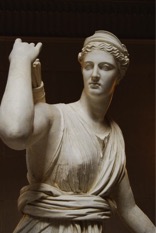In her talk, titled Finding Their Place: The History and Conservation of Plaster, Diane Fullick, an objects conservator in private practice, presented on her on-going conservation treatment of plaster casts at the Maryland Institute College of Art (MICA).
In addition, the history of the plaster casts, their role at MICA and in the development of the culture of Baltimore, and the rise and fall of plaster casts were discussed.

In 1881, a large collection of plaster casts were purchased from Paris, Rome, and London for the recently built Peabody Gallery of Art. The casts enabled the Peabody to bring famous works of art to the Gallery, thus advancing the goals of creating the first cultural institution in the city of Baltimore. Certain hours were devoted to letting students come in and study the casts. In the mid to late-19th century, plaster casts were at their height of popularity, though this was to be short-lived. In the early part of the 20th century, a decline in interest in Classical art and the rise of the modern and avant-garde movement in art resulted in the diminished popularity of plaster casts. As a result the Peabody Institute began to deaccession their collection of plaster casts. In 1924, the smaller collection was transferred to MICA to be used in their classrooms.
In 2008, Diane Fullick began to examine the plaster casts for future conservation treatment. Of the thirty-four casts, Fullick decided that eight were high priority for conservation treatment. These casts were extremely dirty, disfigured by many layers of paint, and had losses and scrapes caused by constantly being moved from classroom to classroom. Initial cleaning tests demonstrated that surface cleaning would not be enough and the casts would greatly benefit from paint removal and proper fixing of cracks and losses.
Fullick described the treatment of the plaster cast of “Diana and the Stag” in great detail. The cast had numerous cracks, part of an arm was broken and the armature was exposed, and the horns and ears of the stag were missing, and details of the statue were obscured by the many layers of paint that had been applied over the years. The first step Fullick carried out was to remove the paint layers. This was done using a water-based alkaline paint remover which was applied to the plaster surface and then paper towels saturated with additional paint stripper were then layered on the cast. Wrapped in plastic, the paper towels soaked in the paint remover dwelled for approximately 12-18 hours. Most of the paint was then removed mechanically and with solvents. For more stubborn paint, the paint remover was applied to directly to the paint, allowed to sit for between thirty minutes and two hours, and then removed with cotton swabs and acetone. Next, Fullick repaired the arm using Acryloid B-72 and filled deep cracks with Acryloid B-72 bulked with micro-balloons. A thin layer of Flugger, an acrylic-based fill material, was applied at the surface and then toned with Golden acrylic paints. Fullick used stainless steel mesh to create the armature for the horn and ear replacements. It was decided not to recreate new legs on front of the stag because they could be easily damaged and the legs were not part of the original sculpture.
Next, Fullick quickly described the treatment carried out on a cast of a figure from the Parthenon. (The sculpture was previously restored by MICA students under the guidance of a MICA instructor, however, there are no treatment records. It is known that the restoration included repainting to emphasize muscle definition.) The treatment carried out by Diane Fullick included a reduction of paint layers, similar to that done on “Diana and the Stag.” One of the figure’s legs was broken and presumed lost, and the other leg was intact, but very dirty. The intact leg was cleaned with an acetone-water gel. The presumably lost leg was found in a closet, but in pieces. Fullick repaired the leg using Acryloid B-72 and inserted fiberglass strips to further support the leg.
To conclude her talk, Fullick discussed the future of the plaster casts. She was not sure what the future holds for the casts, but was confident that they would be continue to be used extensively at MICA as teaching tools. The casts continue to be an integral part of the culture of Baltimore as their history brings together figures whose names are integral to the city’s history.
Summarized by Laura McNulty